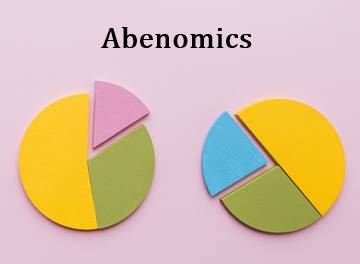Abenomics
Japan has been experiencing economic deflation for over two decades. The masses have been pursuing the government to come up with a good plan of revitalising the Economy. In 2013, Japanese Prime Minister Shinzo Abe introduced a three-pronged approach, which is now known as Abenomics.

The goal of the approach was to boost domestic demand and the Gross Domestic Product (GDP) while rising Inflation to 2%.
What is Abenomics?
Abenomics is a set of monetary and fiscal policies combined with structural reforms. These policies helped Japan from growing out of its decades-long deflation. The policy refers to three structural arrows that Mr Shinzo Abe introduced.
1. Fiscal Stimulus
The fiscal stimulus was introduced in 2013. This included Economic Recovery measures worth $210 billion out of which $116 billion was the Japanese government’s direct spending. This package was Japan’s second-largest package and it focused on building big infrastructure projects like bridges, tunnels and roads resistant to earthquakes. In 2014, a 5.5 trillion Yen’s boost was provided after the elections and PM Abe introduced another package worth 3.5 trillion yen.
Talk to our investment specialist
2. Monetary Policy
The Bank of Japan’s (BOJ) biggest asset purchase program is the main successful ingredient of Abenomics. The Wall Street Journal called it a ‘gigantic experiment in monetary policy’.
The BOJ injected liquidity into the economy and pushed certain interest rates into the negative territory. Injecting liquidity into the economy is also called a quantitative easing policy.
3. Structural Reform
This arrow included cutting business regulations, liberalising the labour Market along with the agricultural sector and cutting corporate Taxes. It also aimed at increasing workforce diversity.
Effect of Abenomics in Japan
One of the three arrows, the monetary policy, aimed at reducing real interest rates. This had a significant effect on the weakening of Yen. In 2013, it was told that the weakening of Yen could be a good thing for the Japanese economy because it could help boost exports and other currencies could but more of Japanese-manufactured products. The more manufacturers sell, the more are the corporate Earnings, which would translate into increased business investment.
However, as of December 2017, the inflation rate was recorded to be 1%, which was lower than the target of 2%. But one good thing to consider about the recent growth in the Japanese economy is the demand for high-tech electronics. With the three-arrow policy, Japan was able to turn to layout-saving technology, which has helped the economy combat its shortage with labour and boosted productivity levels. There has been increased tourism which has also helped in strengthening the national economy.
Critical Review of Abenomics
Various critics have argued that Abenomics brings some major risks. A few think that this could bring in hyperinflation while others believe the major move could do only a little to aid the deflated Japanese economy.
All efforts have been made to ensure the information provided here is accurate. However, no guarantees are made regarding correctness of data. Please verify with scheme information document before making any investment.




